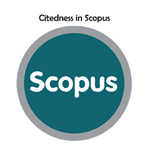Pengaruh Waktu Ekskresi terhadap Residu Kafein pada Urine Responden Pengkonsumsi Teh Celup Hitam menggunakan Pereaksi Parry
Abstract
Addictive substance is NAPZA component. Caffeine is one of addictive substance that has psychoactive properties, induce addicted, and as drug for eleminating drowsiness, mood enhancer, performance, and vigilance. This aim study is identification residual of caffeine in urine and urine effect excretion time after consumed a tea to caffeine visible in urine. Black tea is one of caffeine source. Caffeine reabsorbed in tubules kidney and excretion through urine . This study use 10 urine of human as sample examination. Each of them get instruction to consuming of 250 ml tea and record the time after consuming tea till urination. The urine extracted by eter using separating funnel. The urine extract is identified by Parry Reaction in qualitative method. This study has been shown that all of urine sample have contained caffeine residual after consuming tea with green complex colour marked due to Parry Reaction and it visible from 10 minutes until 3 hours after consuming tea. But, this study need some developments about comparing other reaction to identification caffeine in qualitative method, quantitative method to show level of caffeine in and out from body, and special treatment for subjects.
Keywords
Full Text:
PDFReferences
Alsabri, S.G, BscPharm, MS., Mari, W.O., MD, MS., Younes, S., MD, MS., Alsadawi, M.A., MD, & Oroszi, T.L., MS, EdD. 2018. Kinetic and Dynamic Description of Caffeine. Journal of Caffeine and Adenosine Research. 8(1): 3-9
Astill, C., Birch, M.R., Dacombe, C., Humphrey, P.G., & Martin, P.T. 2001. Factors Affecting the Caffeine and Polyphenol Contents of Black and Green Tea Infusions. J. Agric. Food Chem. 49(11):5340-5347
Chin, J.M., Merves, M.L., Goldberger, B.A., Cone, A.S., Cone, E.J. 2008. Caffeine Content of Brewed Teas. Journal of Analytical Toxicology. 32:702-704
Dewi, R.I,S. 2016. Karakteristik Individu Pengguna dan Pola Penyalahgunaan NAPZA pada Narapidana di Lembaga Pemasyarakatan Maninjau. Jurnal Kesehatan Medika Saintika. 7(1): 77-86
Fajar, R.I., Wrasiati, L.P., & Suhendra, L. 2018. Kandungan Senyawa Flavonoid dan Aktivitas Antioksidan Ekstrak Teh Hijau pada Perlakuan Suhu Awal dan Lama Penyeduhan. Jurnal Rekayasa dan Manajemen Agroindustri. 6(3): 196-202
Fauziah, F., Zulharmita, & Ningsih, W.2017. Pembuatan Kafein Benzoat Secara Semisintesis dari Seerbuk Teh Kayu Aro. Jurnal Farmasi Higea. 9(1):9-19
Fenton, R.A., Poulsen, S.B., Chavez, S.D.L.M., Soleimani, Manoocher, Busslinger, M., Rieg, J.A.D., & Rieg, T. 2015. Caffeine-Induced Diuresis and natriuresis is Independent of Renal Tubular NHE3. Am J Physiol.
Kertadjaja, W.2005. Manfaat Teh (Camelia sinensis). Meditek. 13(34):31-35
Kim, H.J., Choi, M.S., Rehman, S.U., Ji, Y.S., Yu, J.S., Nakamura, K., & Yoo, H.H. 2019. Determination of Urineary Caffeine Metabolites as Biomarkers for Drug Metabolic Enzyme Activities. Nutrients.11 : 1-15
Kumar, T.H., Mounika, P., Likhitha, S.S., Aswini, S., Kavya, T., Sudandhini, T., & Sree, A.V. 2019. Application of Stability Indicating UV Spectrophotometric Method for Estimation of Caffeine in Gel Formulation, Plasma, and Urine. International Journal of Pharmaceutical Sciences and Research. 10(12) : 5481-5488
Latunra, A.I., Johannes, E., Mulihardianti, B., & Sumule, O. 2021. Analisis Kandungan Kafein Kopi (Coffea arabica) pada Tingkat Kematangan Berbeda Menggunakan Spektrofotometer UV-Vis. Jurnal Ilmu Alam dan Lingkungan. 12(1):45-50
Maramis, R.K., Citraningtyas, G., Wehantouw, F. 2013. Analisis Kafein dalam Kopi Bubuk di Kota Manado Menggunakan Spektrofotometer UV-Vis. Pharmacon Jurnal Ilmiah Farmasi. 2(4) : 122-128
Martono, B., & Udarno, L. 2015. Kandungan Kafein dan Karakteristik Morfologi Pucuk Enam Genotipe Teh. J.TIDP. 2(2): 69-76
Mutmainnah, N. 2017. Penentuan Suhu dan Waktu Penyeduhan Batang Teh Hijau Terhadap Kandungan Antioksidan Kafein, Tanin dan Katekin. Makassar: Fakultas Sains dan teknologi UIN Alauddin Makassar. Skripsi
Nehlig, A. 2018. Interindividual Differences in Caffeine Metabolism and Factors Driving Caffeine Consumption. Pharmacological Review. 384 - 411
Sholihah, Q. 2013. Efektivitas Program P4GN Terhadap Pencegahan Penyalahgunaan NAPZA. Jurnal Kesehatan Masyarakat. 9(1): 153-159
Sihaan, M.A. 2019. Korelasi Antara Jumlah Kafein yang Dikonsumsi dalam Air Kkopi dengan Jumlah Kafein yang Diekskresikan dalam Urine. Majalah Ilmiah Methoda. 9(2): 86-88
Suaniti, N.M., Wirajana, I.N., Ariati, N.K., Manurung, M. 2018. Pengetahuan Dan Pemahaman Dini Narkoba Dan Zat Aditif Pada Generasi Muda Sebagai Aset Bangsa Di Desa Mengwi Badung. Buletin Udayana Mengabdi. 17(4):67-74
Tfouni, S.A.V., Camara, M.M., Kamikata, K., Gomes, F.M.L., & Furlani, R.P.Z. 2017. Caffeine in teas: levels, transference to infusion and estimated intake. Food Science and Technology. 38(4): 661-666
Thorn, C.F., Aklillu, E., McDonagh, E.M., Klein, T.E., & B, R. 2012. PharmGKB Summary : Caffeine Pathway. Pharmacogenet Genomics. 22(5) : 389-395
Wanyika, H.N., Gatebe, E.G., Gitu, L.M., Ngumba, E.K., & Maritim, C.W. 2010. Determination of caffeine content of tea and instant coffee brands found in the Kenyan market. African Journal of Food Science. 4(6): 353-358
DOI: https://doi.org/10.37311/ijpe.v2i3.22162
Refbacks
- There are currently no refbacks.
Copyright (c) 2023 ANIK EKO NOVITASARI

Indonesian Journal of Pharmaceutical Education is licensed under a Creative Commons Attribution-NonCommercial-ShareAlike 4.0 International License.



